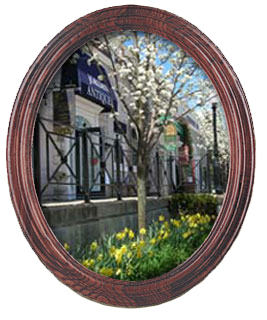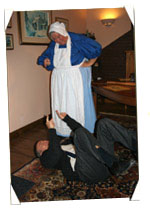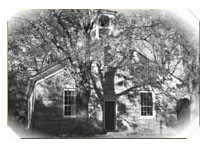2008 Tour
THE VILLAGE OF JORDAN

The village of Jordan, which was once called Hoy, was founded in 1840 by Jacob Snure, an immigrant from the United States. The village of Jordan was a hub of commerce in the 1840’s. There were 2 or 3 hotels, including the Jordan House which dates back to that time period, a post office, several stores and at one time two town halls. It also supported a shipping industry in the Jordan Harbour to ports as far away as England. In 1846, the population was 200 people.
THE OLD POSTAL WAGON
 The postal wagon which now resides at the Jordan Museum of the Twenty was used in the Jordan area for up to 30 years when its services were retired in 1952. Six days a week it’s mail delivery took a total of 9 miles or 15 km. The price of postage was very high and was cost prohibitive for many of the early settlers. Therefore, letters were often sent without postage and it would be the responsibility of the receiver to pay the postage at the other end. Money also was often sent via the mail wagon and the drivers had to keep a sharp eye for robbers.
The postal wagon which now resides at the Jordan Museum of the Twenty was used in the Jordan area for up to 30 years when its services were retired in 1952. Six days a week it’s mail delivery took a total of 9 miles or 15 km. The price of postage was very high and was cost prohibitive for many of the early settlers. Therefore, letters were often sent without postage and it would be the responsibility of the receiver to pay the postage at the other end. Money also was often sent via the mail wagon and the drivers had to keep a sharp eye for robbers.
FIRST PLAY
– ONCE UPON A TIME IN JORDAN –
Playwright: John van der Beek
 In the 1840’s, the local post office was the hub of information. Nothing much slipped by the watchful eyes of post mistress Isabella Snure, including who was receiving a letter from whom and what it might be about.
In the 1840’s, the local post office was the hub of information. Nothing much slipped by the watchful eyes of post mistress Isabella Snure, including who was receiving a letter from whom and what it might be about.
CAST IN ORDER OF APPEARANCE
| Clark Francise Isabella Snure Noah Albright Mrs Perry Mrs High Mrs Hunsberger James Black Jacob Snure Isaac Green Augusta Schnick |
Kristiaan Hansen Samantha Sargent Sharon Fecik Jonathan Kotwa Caroline Hansen Joan Edwards Maria Toye Mark Miszturak Terry Kotwa Dennis Castello Liz Brenneian |
Snure-Sedgewick Home
Now The Mosaika Gallery
Owner: Robin and Randy Loewen
3769 Main Street
Circa 1880
Built in the Queen Anne style of architecture, originally this building housed the post office until 1970. In the 1800’s, it was common for generations to carry on certain professions. Such was the case of the postmaster. Jacob Snure took over as postmaster in Jordan in 1853. His descendents carried on the tradition until 1962 with Alene Snure being the last postmaster of her family.
SECOND PLAY
– THE HAIR OF THE DOG –
Playwright: David Fanstone
Rum running was rampant in those days and even  the most respectable citizens were sometimes involved. Local men appointed themselves as local militia in order to “deal with” the problems. Some of these local militia were less effective than others, often with rather comic results.
the most respectable citizens were sometimes involved. Local men appointed themselves as local militia in order to “deal with” the problems. Some of these local militia were less effective than others, often with rather comic results.
CAST IN ORDER OF APPEARANCE
| Peter Hoogenboom Lavinia Hoogenboom Silas |
Calvin Quirk Marilyn Bellfontaine Ken Southward |

Twin house to the Snure-Sedgewick Home
Now the Glass Arts and Crafts
Current Owner: Tina Howes
3773 Main Street, Jordan
Circa 1880
This house was also believed to have been built by a descendent of Jacob Snure. It is believed that two brothers built both houses and lived side by side.
THIRD PLAY
– FREEDOMLAND –
Playwright: Sheila Laundry
By the 1840’s, the Niagara area had become a safe haven for slaves  escaped from the southern states. Many had harrowing tales to tell of their journeys on the “underground railroad”.
escaped from the southern states. Many had harrowing tales to tell of their journeys on the “underground railroad”.
CAST IN ORDER OF APPEARANCE
| Mrs Culp Dr Simeon Goss Sarah Goss Benjamin Albright |
Bailee Mailvoire Jim Myles Wendy Quirk Trevor Blake |
Kiddick House
Santa Fe Trading Lifestyle and Vanity Fair
Current Owner: Pam Mason and Karen D’Angelo
3799 Main Street
Circa 1840
 The house originally functioned as the home and offices of many doctors, including Dr. Elisha Jessop and Dr. Addy. In later years it was the home of the famous potter Tess Kiddick. It probably had a wraparound porch at one time and the unique brickwork and wood flooring is still in evidence today. The original mounting stone for this house is located at the museum in front of the Fry House.
The house originally functioned as the home and offices of many doctors, including Dr. Elisha Jessop and Dr. Addy. In later years it was the home of the famous potter Tess Kiddick. It probably had a wraparound porch at one time and the unique brickwork and wood flooring is still in evidence today. The original mounting stone for this house is located at the museum in front of the Fry House.
FOURTH PLAY
– FIDDLER IN THE HOUSE –
Playwright: Neil Galloway
 Sea going men of questionable pursuits had many an exciting tale to tell. Captain Joe is no exception. Everyone – well, almost everyone – gets caught up in his tales of the sea. Come on in an’ hear one of these whalin’ stories for yourself. Oh, by the way, hope you’re not afraid of the occasional ghost.
Sea going men of questionable pursuits had many an exciting tale to tell. Captain Joe is no exception. Everyone – well, almost everyone – gets caught up in his tales of the sea. Come on in an’ hear one of these whalin’ stories for yourself. Oh, by the way, hope you’re not afraid of the occasional ghost.

CAST IN ORDER OF APPEARANCE
| Captain Joseph Moyer John Fanning John Spence Abraham Moyer Fiddler |
Jens Hansen Rob Murre Mike Cipryk Jason Swenor Beth Bartley |
Jordan Vinegar Works
Cave Spring Cellars
Owner: Len Pennachetti and Helen Young
Circa 1870
This building was originally the Jordan Vinegar Works. It was established by Clark Snure and his son Elderidge who made and sold, as advertised, “Jams, Jellies, Evaporated Fruits, Cider and Pure Cider Vinegar”. Snure shipped barrels of dried apples throughout Ontario and overseas to England. Women operated the presses in the valley below. Archibald Haines, along with William Aiken of Dunnville, recognized the potential of the local grapes and established Jordan Wines, taken over in 1964 by the Danforth Wine Company, controlled by Seagrams. Today, this beautiful facility still plays an important part of the fabric of Jordan now housing part of the Jordan Historical Museum, various boutiques, Cave Spring’s winery shop and their world renowned restaurant, On The Twenty.
Fifth Play
– THE MEANING OF CHRISTMAS –
Playwright: Katherine Albers

No Christmas in the village would be complete without the traditional school concert. We hope you enjoy this one a little more than some of the women in this village. I ask you, the nerve of some people! Come on in and join us in our search for the true meaning of Christmas.
CAST IN ORDER OF APPEARANCE
| Jacob Honsberger Franklin Green George Eckhardt Miss Valerie Burham Mrs. Nash Mrs. Wismer Mr. Nash Mr. Wismer Emily Fretz Audrey Johnson Shirley Green Louise Eckhardt Anneliese Fretz Matilda Fisher Victoria Fisher Albert Fisher |
Ben Cipryk Nathan Kretz Spencer Thomas Jeannette Heil Betsy Tauro Carola Hicks Damian Coleman John Murre Sarah Nicholson Samantha Cooke Basia Krzyzhowski Megan Van Weeldon Sarah Bradshaw Karen Harkness Lyndsay Cooke Ben Friesen |
Jordan Museum of the Twenty
Town of Lincoln
Helen Booth, Curator
Circa 1859
The first school was built in 1839 but destroyed by fire in 1858. It was replaced with the current grey stone building at a cost of $1,221.
A typical salary for in a teacher in 1847 would have been $97 for six months. One of the early contracts for teachers states that if a teacher should come to work intoxicated he would not be paid for his time whiltst in that condition. The current structure served the needs of the community until the mid 1940’s.
Misses Nettie and Nan’s Tea Room
 After your tour stop in for a strong cup of tea, coffee or some cider and some old fashioned, mouth watering desserts to help celebrate a Victorian Christmas season.
After your tour stop in for a strong cup of tea, coffee or some cider and some old fashioned, mouth watering desserts to help celebrate a Victorian Christmas season.
All the treats in Misses Nettie and Nan’s Tea Room are homemade with the best ingredients. As always, local volunteer bakers participated in creating these scrumptious delights to warm your hearts and tummies!
Nan and Nettie always have something else “cooking” in the kitchen to entertain you as well. You are guaranteed to eat well, relax, visit with friends and leave with a smile.
Miss Nettie (proprietress) – Diana Bujas
Miss Nan (proprietress) – Suzanne Symsyk
Servers
| Jenn Yurkiw Tineke Leech Elaine Hooker Vera delaat Barb Hudson Jill Nicholson Laura Brock |
Vicki Bedford Pat Konkle Cathy Cookman Joyce Gillespie Margaret Maynard Jennifer Turn |
Bakers
| Diana Bujas Barb Hudson Brenda Saunders Elaine Hooker Joyce Gillespie Pat Konkle Jennifer Southward Janet Gatecliff The Beamsville Bakery |
Suzanne Symsyk Sue Miszturak Jennifer Turner Vicki Bedford Jenn Yurkiw Cheryl Steele Kay Yardley Sobey’s Old Post Bakery |
Additional Cast members:
Jenn Yurkiw – Jeannette
Makenzie Smith – played Louise – niece of Nan and Nettie
Xanthe Fiocca – played Emma – niece of Nan and Nettie

ST. JOHNS ANGLICAN CHURCH
3694 MacKenzie Drive, Jordan
Reverend Philip Ruch, Pastor
Circa 1841
Constructed in 1841, the church is thought to be one of the first Tractarian (style) churches in Canada. The history of the church is significant due to the notable personages associated with its founding.
George Ball (founder of the settlement of Glen Elgin, now Balls Falls) donated the four acre parcel for the church and nearby cemetery.
The church itself was built by Newton Perry, a renowned master builder in the Niagara Region and is considered to be his masterpiece. The nearby cemetery is the resting place of many early settlers including members of the Butlers Rangers.
Stroll through past Lamplighter Tours
View photos of past performances in our gallery.